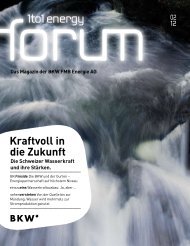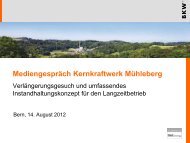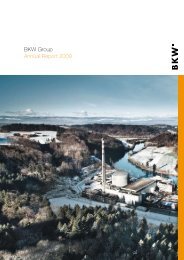BKW FMB Energy Ltd Annual Report 2003
BKW FMB Energy Ltd Annual Report 2003
BKW FMB Energy Ltd Annual Report 2003
Create successful ePaper yourself
Turn your PDF publications into a flip-book with our unique Google optimized e-Paper software.
interest expenses. These are fi nanced<br />
over the long term with phased maturity<br />
dates to minimise the impact of interest<br />
rate changes on the earnings situation.<br />
In addition, interest rate hedging instruments<br />
are used where necessary. Cash is<br />
invested over the short to medium term<br />
primarily in fi xed interest positions to<br />
minimise the impact of interest rate<br />
changes and price fl uctuations.<br />
Credit risk<br />
Credit risk includes the risk that a counterparty<br />
will be unable or unwilling<br />
to discharge its obligation and cause a<br />
fi nancial loss. Active risk management<br />
with defi ned limits per counterparty is<br />
practised with respect to trade accounts<br />
receivable and the investment of funds.<br />
3.13 Derivative fi nancial instruments<br />
The fair value of a derivative fi nancial<br />
instrument is the amount for which a<br />
third party would acquire the rights and<br />
obligations arising from such a derivative<br />
fi nancial instrument. The amount is calculated<br />
using recognised valuation methods<br />
or the prevailing price on the balance<br />
sheet date. The published fair values may<br />
differ from the published fair values for a<br />
liquidated sale, due to fl uctuations in relevant<br />
market data. Value fl uctuations are<br />
continually charged to income. The operating<br />
results of energy business derivative<br />
fi nancial instruments are recorded<br />
in the operating result, and the operating<br />
results of derivative fi nancial instruments<br />
for currencies and interest are recorded in<br />
fi nancial income.<br />
3.14 Contingencies<br />
Measurement of the provision for nuclear<br />
waste disposal is essential for assessment<br />
of the balance sheet of <strong>BKW</strong>. The<br />
industry calculates shared, detailed costs<br />
for decommissioning and the disposal of<br />
nuclear waste. These cost calculations<br />
are examined by the Swiss government,<br />
which manages fi nances arising from<br />
the provision for nuclear waste disposal.<br />
The estimates of <strong>BKW</strong> are applied for<br />
38<br />
plant-specifi c obligations. Payment to the<br />
funds managed by the Swiss government<br />
is stated as a receivable at net present<br />
value. In accordance with the ordinance<br />
governing the state funds, operators must<br />
make up any future shortfalls or are entitled<br />
to reimbursement of future surplus<br />
funds. These receivables or obligations<br />
are stated as contingent liabilities in the<br />
case of a shortfall, or contingent assets in<br />
the case of a surplus. The value of such<br />
shortfalls or surpluses can only be determined<br />
in the future.<br />
Errors in cost calculations and changes<br />
in policy requirements for decommissioning<br />
and nuclear waste disposal, as<br />
well as sustained, long-term discrepancies<br />
between the fi nancial income from<br />
state funds and the calculated net present<br />
value, may affect the Group’s earnings<br />
situation.<br />
3.15 Pension plan<br />
The Group operates various pension<br />
plans. The individual plans are recorded<br />
as defi ned benefi t or defi ned contribution<br />
pension plans according to IAS 19.<br />
Defi ned benefi t plans are subject to periodic<br />
valuation (generally every 3 years)<br />
and revision by qualifi ed independent<br />
actuaries. They are calculated using the<br />
projected unit credit method. Until this<br />
obligation is recalculated, employees’<br />
acquired benefi ts are updated based on<br />
the selected parameters. If subsequent<br />
calculations differ by less than 10% (corresponding<br />
to the ”corridor” defi ned in<br />
IAS 19 Paragraph 92), these benefi ts are<br />
recorded unchanged. If the difference exceeds<br />
the permissible corridor, the benefi<br />
ts are recorded using the straight-line<br />
method over the average remaining working<br />
life of employees participating in the<br />
plan if the difference is also recorded on<br />
the balance sheet.<br />
If an obligation arises from this calculation,<br />
the <strong>BKW</strong> Group records this in the<br />
balance sheet at the anticipated value<br />
of the fi nancial cash outfl ow. Gains are<br />
accounted for only to the extent of the<br />
anticipated future benefi t for the <strong>BKW</strong><br />
Group.<br />
Contributions to defi ned contribution<br />
plans, such as the state pension plan,<br />
are charged in the period to which they<br />
relate.


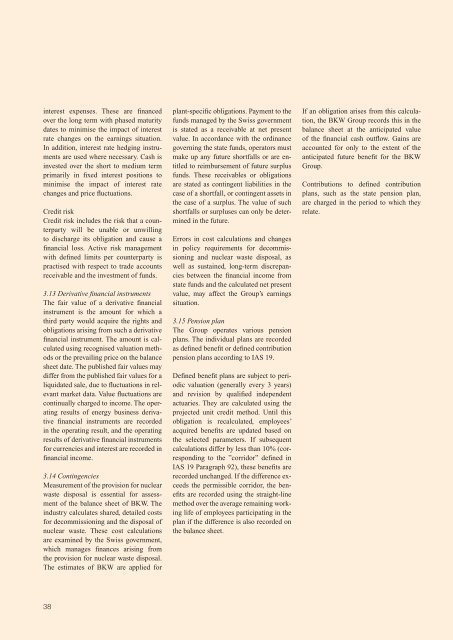
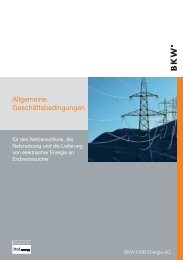

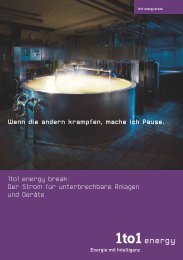
![Geschäftsbericht 2002 [PDF, 0.8 MB] - BKW](https://img.yumpu.com/10617024/1/184x260/geschaftsbericht-2002-pdf-08-mb-bkw.jpg?quality=85)
![Geschäftsbericht 2001 [PDF, 0.9 MB] - BKW](https://img.yumpu.com/10616911/1/184x260/geschaftsbericht-2001-pdf-09-mb-bkw.jpg?quality=85)
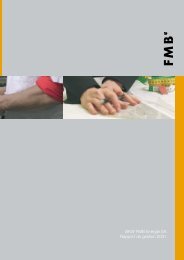


![Referat Streiff 11.07.2006 [PDF] - BKW](https://img.yumpu.com/9314454/1/184x260/referat-streiff-11072006-pdf-bkw.jpg?quality=85)
